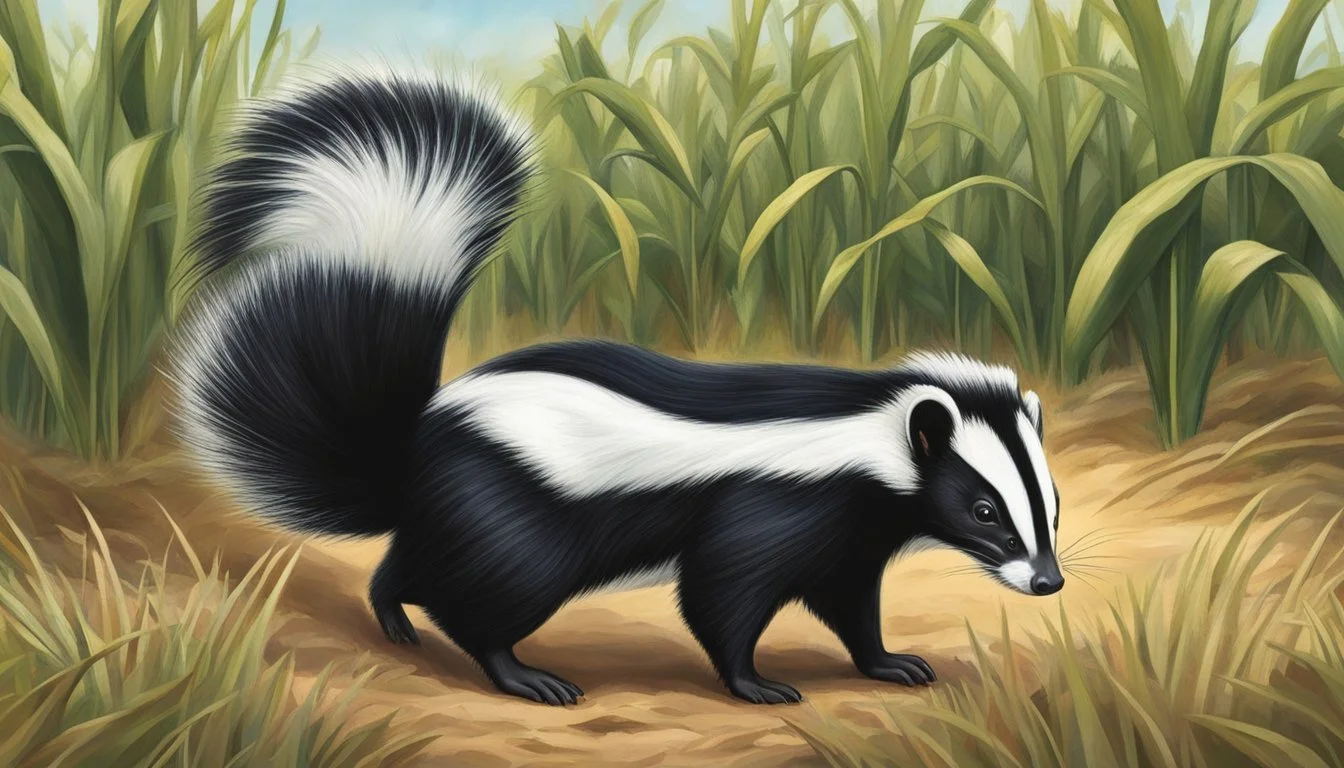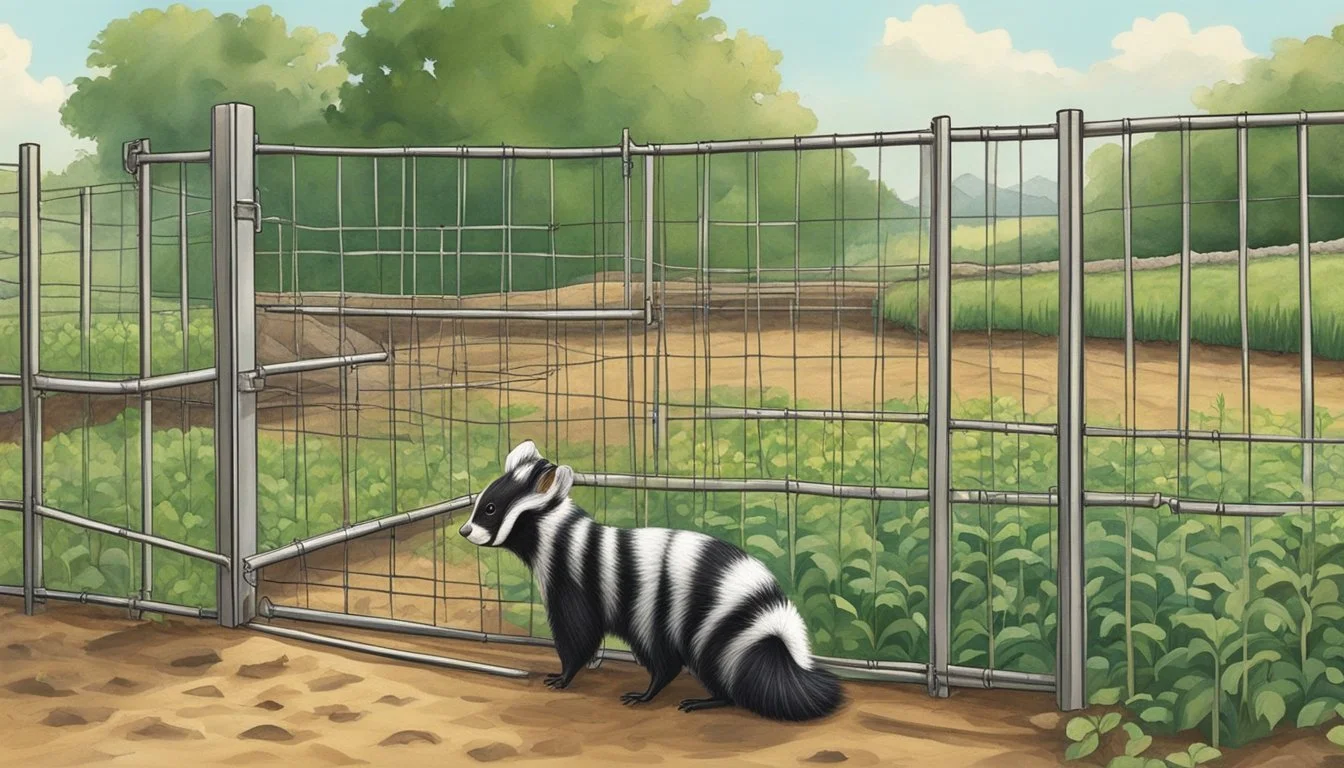Protecting Crops from Striped Skunk
Effective Deterrence Strategies
The striped skunk, or Mephitis mephitis, is a North American native species recognized by its distinctive black and white coloring. These skunks are found throughout the United States, southern parts of Canada, and northern Mexico, thriving in a variety of habitats including woods, fields, and even urban areas. While they play a role in the ecosystem by controlling insect populations, they can pose challenges for agriculture. Farmers often seek methods to protect their crops from the striped skunk, as these nocturnal creatures are known to forage for food in gardens and fields, occasionally causing significant damage.
Understanding the behavior and habitat preferences of the striped skunk is essential for effective crop protection. These animals are omnivores and are attracted to a wide range of food sources, which can include agricultural produce. Their keen sense of smell leads them to ripe fruits and vegetables, as well as available pet foods or garbage, which can inadvertently draw them to cultivated areas. Developing strategies to deter the striped skunk involves creating an unfavorable environment for skunks to enter and minimizing access to food sources that attract them.
Protective measures against striped skunks do not necessarily involve harming the animals, as there are numerous humane and non-lethal methods that can be employed. Strategic fencing, use of repellents, and prompt harvest of ripe crops can reduce the appeal of the area to skunks. It's crucial to pair such protective actions with an understanding of local wildlife laws, especially since skunks are protected in some regions. With the right approach, it is possible to coexist with these animals while still safeguarding valuable agricultural resources.
Biology and Identification
Understanding the biology and identification of the striped skunk is crucial for protecting crops effectively. These animals are distinctive in both appearance and behavior, characteristics that are key to recognizing and addressing their presence in agricultural areas.
Physical Characteristics
Striped skunks (Mephitis mephitis) are medium-sized mammals recognized for their long, bushy tails and black fur with white patterns that typically include two broad stripes running from the head to the tail. They usually measure between 18 and 32 inches in length and weigh from 1.5 to 13 pounds, with size varying by geography and season.
Skunk Species
While there are multiple skunk species, the most common in North America and often found near crops is the striped skunk. It belongs to the order Mammalia and has the scientific name Mephitis mephitis.
Dietary Habits
As omnivores, striped skunks’ diets include insects, fruits, nuts, small mammals, amphibians, reptiles, and carrion. Their varied diet makes them adaptable to different environments but can lead them to forage in fields where crops are grown.
Reproductive Behavior
Mating occurs once a year, typically in late winter. Females may delay implantation, with a gestation period of about 60 to 75 days. Young, also known as kits, are born in the spring, with litters ranging from four to seven.
Habitat and Range
Habitats for striped skunks are diverse, including fields, forests, grasslands, and especially agricultural lands. Their home ranges are notable for their proximity to water sources and cover, including both wild and urban settings.
Seasonal Behavior
Movement in striped skunks decreases in the winter months, unlike true hibernation. They become more active in spring and summer, with increased foraging that coincides with crop growth, leading to potential conflicts with agriculture.
Sensory Capabilities and Communication
Striped skunks rely heavily on their sense of smell and have less developed vision. They communicate through various means, including scents and body language, often using warning signals when threatened.
Skunk Predators and Threats
Predators such as coyotes, bobcats, eagles, raccoons, and foxes may hunt striped skunks. However, their potent musk serves as a powerful warning and defensive behavior, deterring most threats.
Typical Behaviors
Identifying skunk activity is often related to their nocturnal behavior. They are ground dwellers and dig burrows for shelter or may occupy other animals' abandoned dens.
Health and Diseases
Striped skunks can carry and transmit rabies, a disease affecting the central nervous system. They may also be susceptible to other diseases common among wild mammal populations.
Crop Protection Strategies
To safeguard crops from the disruptive behavior of striped skunks, farmers can employ a variety of effective strategies. Multifaceted approaches combining understanding of skunk behavior with physical deterrents and ethical wildlife management are essential for protection.
Understanding Skunk Behavior
Striped skunks are nocturnal mammals that often forage for food at night. They have a diverse diet, eating both plants and small animals, such as insects and eggs. Recognizing the striped skunk's patterns of movement and the signs of their presence, including the distinct smell and diggings, is crucial for crop protection.
Physical Barriers and Fencing
A sturdy fence can be an effective deterrent, as skunks lack the size and claws suited for extensive climbing. To properly protect a farmland or pasture, a fence should extend below ground level to prevent skunks from digging under to access food sources. The fence should also be secure enough to withstand other animals that may breach it.
Habitat Alteration
Modifying the surrounding habitat can make the area less appealing to striped skunks. This includes clearing vegetation and cover skunks use for shelter, as well as minimizing sources of water near the crops. Limiting habitat resources can be an effective management tool.
Use of Repellents
Certain repellents, either commercial or natural, can help deter skunks from entering farmland. Repellents that target the skunk's keen sense of smell without causing harm can be part of a non-lethal management strategy. These should be used in accordance with local laws and ethics.
Safe Capture and Relocation
Traps can be used to capture and relocate skunks when other methods are insufficient. For humane trapping, one should use live traps positioned near the skunk's den or foraging areas and relocate the skunk to a designated area according to local wildlife management regulations.
Lethal Control Methods
As a last resort, lethal methods may be used when skunk predation threatens to significantly impact crop yield. Any lethal control should be conducted in line with legal and ethical guidelines established for wildlife management, as well as considering the potential impact on local ecosystems.
Frequently Asked Questions
Protecting crops from striped skunks involves employing humane and effective strategies to deter these nocturnal creatures from encroaching on personal property.
What methods are effective for deterring skunks from vegetable gardens?
One can install motion-activated sprinklers that startle skunks with bursts of water, deterring them from entering vegetable gardens. Additionally, securing the perimeter with skunk-proof fencing that extends underground can prevent them from digging their way in.
How can I safely remove skunks from my farm without harming them?
Live traps can be used to capture and remove skunks without injury. Once trapped, they should be released in a suitable habitat far from human dwellings. It's essential to check local regulations regarding the relocation of skunks.
Which plants can be cultivated to naturally repel skunks?
Certain plants, such as marigolds, emit odors that skunks find unpleasant. Integrating these into the landscape can act as a natural deterrent. For more detailed information on these plants, refer to specialized gardening resources.
What steps can be taken to skunk-proof a yard?
To skunk-proof a yard, it's recommended to secure garbage cans, remove food sources like pet food or fallen fruit, and block potential den sites such as openings under decks or sheds. These steps make the area less attractive to skunks.
Are there any home remedies effective in keeping skunks away from my property?
Home remedies include the use of ammonia-soaked rags or predator urine near gardens and entry points as olfactory deterrents for skunks. These methods capitalize on the skunk's sensitive sense of smell to keep them at bay.
How can I keep skunks out of my yard while ensuring the safety of pets, particularly dogs?
Creating a skunk-deterring environment that is also safe for pets involves setting up a clear boundary using pet-friendly repellents, ensuring there are no accessible food sources, and supervising pets during dawn and dusk when skunks are most active. It's critical to maintain a clean yard to reduce the likelihood of unwanted skunk encounters.





